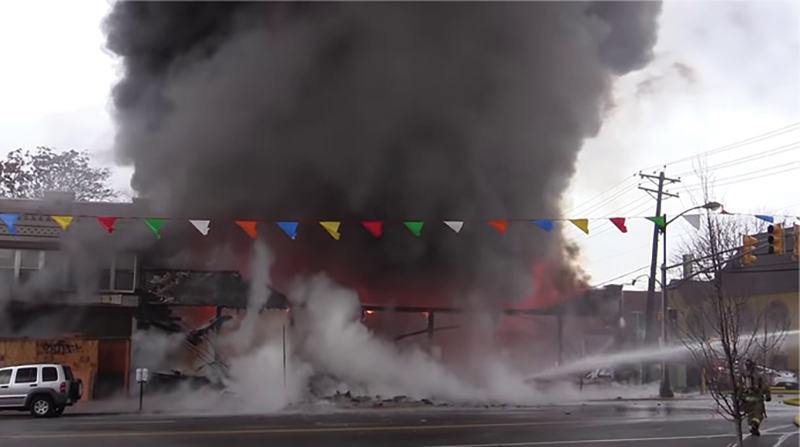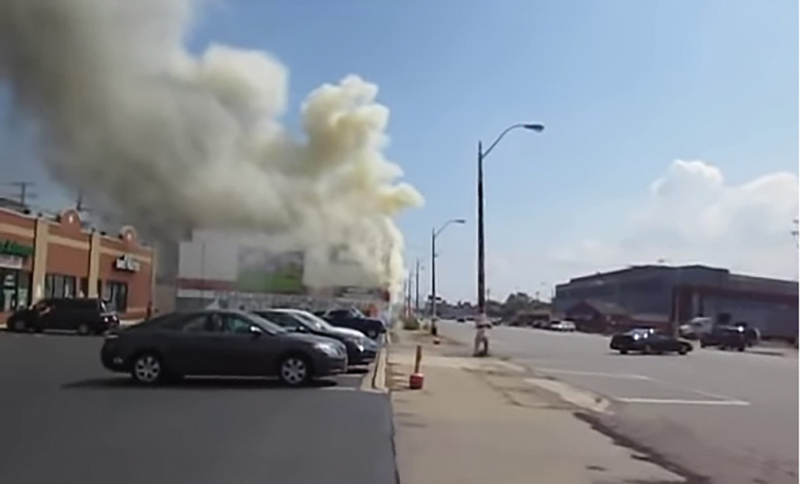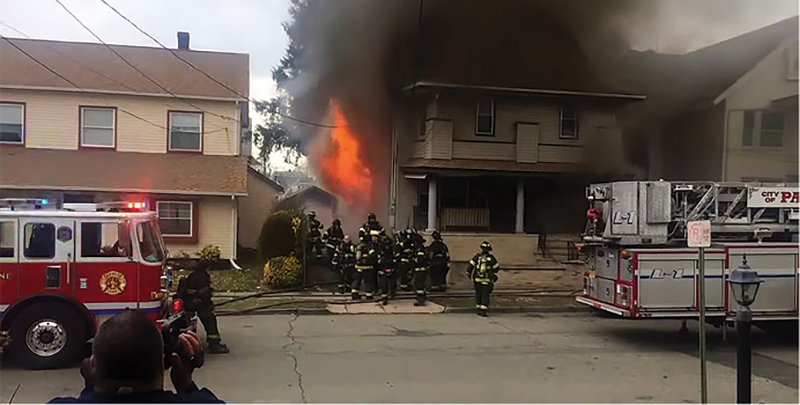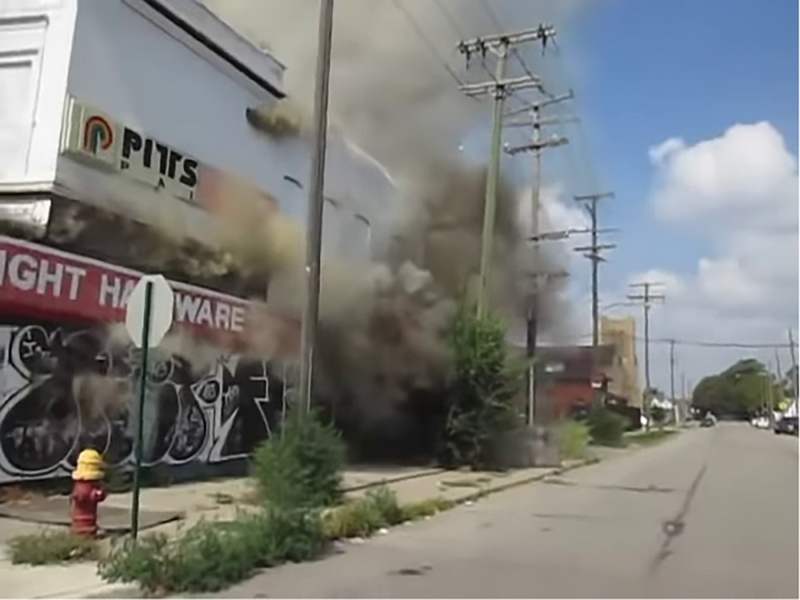TRAINING NOTEBOOK | By Rob Backer
With the proliferation of the Internet and social media, we have all the world’s information, knowledge, and wisdom literally in our pockets and at our fingertips. This means the fire service is blessed with more and easier access to information than those who have come before us. Yet, we still rely on one of our greatest traditions for much of our knowledge and wisdom: the passing on of experience from one firefighter to the next.
- Reading Smoke: Understanding the ‘White Smoke’ Traps
- Phil Jose: Reading Smoke and the Transfer of Command Process
- David Dodson: The Art of Reading Smoke
- Training Bulletin: Reading Smoke
As firefighters, over the course of our careers, we build a “mental rolodex” of experiences and knowledge from the incidents we have run and the lessons we have learned. We recognize the need to pass on our wisdom gained from our experiences to the next generation of firefighters. In the age of social media, we now have an opportunity to share those anecdotes with thousands of other firefighters within seconds. How great is that? However, social media also carries a potential for the spread of inaccurate information. As I scroll and “swipe” my way through training sites, social media pages, and other sources of information, there are far too many “quick reminders” that tell us some variation of “the color of smoke tells you what is burning.”
In my fire service infancy as a wide-eyed volunteer and then a paid recruit, I was taught that white smoke means plastics are burning, black means hydrocarbons are burning, and gray means wood is burning. Not understanding any more than what my mentors and instructors were telling me, who was I to question the information being taught? As it turns out, these assertions are false. How could they be true? Plastics are derived from crude oil (hydrocarbons), but they burn white? We all see black smoke, however thin, at a campfire. Are the logs we’re burning really crude, oil-derived hydrocarbons? Of course not! How is it that I am able to set up a position as some sort of “out team” on a structure fire and watch the smoke change colors as the incident progresses? The smoke is still coming through the same openings with the same filters, but the colors change. What does that mean? How do I know from the exterior that the interior crews are making progress on the attack?
However well-intentioned the anecdotal sharing of “I’ve heard this” or “I saw that” has been when passed from one generation to the next, it is imperative that we share knowledge and information that is backed up by science and research. We must continue the best traditions in the fire service with validated and tested information.
Reading the Color
In smoke reading, the most misunderstood aspect and its implications are the recognition and analyzation of color. The color of smoke does not tell you what is burning; it tells you the stage of heating of the fuel. In any fire, we can see every shade on the gray scale—from a clean, pristine white to a dark, oily black—from the exterior, regardless of what is burning on the interior. Ventilation and fire extension variables may even show us brown or yellow. Developing the ability to properly read smoke helps first-arriving firefighters rapidly identify—without ever having seen any flame—the following:
- The location of the fire.
- The fire’s progress.
- What’s going to happen next.
- How much time we have until “next” happens.

(1) In the front of the building, we see the clean, pristine white smoke produced as steam conversion from water application to extinguished fuels. In the building behind it, black smoke is produced from the flame tips, or “late-stage heating.” (Photo by Ron Bombaro.)
To properly identify these facts, it is critical to identify and analyze the color of the smoke. Following is a quick breakdown of the colors and what they mean for your next size-up.
Black. Black smoke indicates late-stage heating in the case of pyrolysis or incomplete flaming of a fuel—in other words, combustion. It is important to note that the term “late-stage” should not be interpreted to understand that there is a delay or prolonged time frame to progress from early-stage heating to late-stage. Rather, understand that the transition from pyrolyzation to combustion can happen very quickly. Smoke at the flame tips, where it is first produced, will always be black. There are two primary culprits that make smoke black: carbon and oil residue. In fact, carbon is generally one of the most prevalent solids (particulates) in smoke, and crude oil is the most prevalent liquid (aerosol) that we will encounter. Remember, though, that the carbon and oils are very heavy and very sticky. They will stick to whatever they touch (walls, furniture, firefighters) and gradually fall out of the plume because of the effects of gravity as the smoke travels over a prolonged distance (photo 1).
Filtering. Just because we don’t see the “black stuff” from the outside does not mean we don’t have a well-progressed fire inside. The black stuff may be getting filtered, either by distance, through resistance, or a combination of both. Examples of “distance” filtering may include a big-box store with a fire on one side of the building having to travel a large distance for smoke to exit from the other side of the structure. The term “resistance” can be understood to mean that the smoke is pushing through restrictive filters like closed doors or windows or even through small openings in the construction such as cracks in the mortar in between construction blocks.
So, we understand then that because the smoke is filtered as it travels through and out of the box in which it was generated, the distance and resistance-based filtering will provide a visual of a lighter color on the exterior. As such, the presentation of a significant volume of dirty white smoke, discussed in further detail later, indicates a well-progressed fire with smoke that is also being significantly filtered. Analyzing where the filtered smoke is coming from and how it is exiting the structure helps narrow down where in the building the seat of the fire is. In summation, flame tip smoke will always be black, and it is then filtered as it moves through and out of the structure.
Gray. The color gray falls in between black and white. We will always have black smoke from flame tips and, as the smoke travels away from the fire seat, the black smoke will begin to filter out as explained above, both by distance and through resistance. The grays show us that some, but not all, of the black has filtered out. Additionally, we could also be seeing the transition from early to late-stage heating, when we still have some steam from water content pyrolyzation, and that clean, pristine white is now mixing with the black we get from late-stage heating (combustion).
Also, we must consider that when we have a hoseline operating on the interior, the successful application of water will convert to steam, incorporating a clean, pristine white smoke into the late-stage combustion black smoke, leaving us with a gray visual on the exterior. When comparing smoke coming from different openings in the structure, make sure to consider the size/restriction of each opening. Larger openings mean less restriction, which means less filtering than smoke coming through the cracks in the mortar in between bricks of a building or very restrictive openings.

(2) The smoke coming from the eaves of this fire is being filtered as the smoke pushes out through a seam in the construction, leaving some of the “black stuff” behind, and we see gray on the exterior. (Photo by Seth Lutman.)
White. We will read two different kinds of white smoke: The first is a clean, pristine white that rapidly dissipates, and the second is a dirty, ugly white that does not dissipate. The clean white smoke is simply steam. This is indicative of either early-stage heating or the effects of cooling (water application). In the case of early-stage heating, the fuels in question, regardless of composition, are just beginning to be heated, and the first product that they give off when they are heated will be their moisture content. For almost every object, the moisture content given off during early-stage heating is water. The steam we encounter may be indicative of other things as well, such as an activated sprinkler system (a red flag for a cold-smoke fire) or that interior crews have water on the fire and we are seeing the resulting steam conversion.
In photo 1, we can see the clean white from steam conversion. The stuff that makes smoke a dirty white color is ash, which is a particulate or solid matter component of the smoke plume. In its entirety, smoke is an aggregate or a combination of solids, liquids, and gases. Ash is very light, fine, and “silky smooth,” and we will see ash production from any flame as well as a lot of ash from a very hot fire. Because of its silky-smooth nature, it will not be filtered out as it travels through and out of a structure within the smoke plume.
To understand how smoke transitions from black to dirty white, we must understand that the ingredients of smoke that make it black are heavy and sticky. As a result of this stickiness, it will stick to surfaces as it passes through or past them. When all the black has been left behind, all that is left is the stuff that isn’t sticky or heavy, such as the ash. So, lots of ash (dirty white smoke) = a very hot fire with smoke that has been filtered. When you arrive to find white smoke showing, be sure to differentiate between clean and dirty white. When combined with analysis of the other smoke attributes, that can be the difference between an incipient-stage and well-progressed fire as well as a cold smoke fire and an absolute inferno that is deep within the building. Align your tactics accordingly as you gather your “puzzle pieces.”

(3) On the street side of the building, we see a high volume of dirty white smoke, indicating either significant distance or resistance to filter all the black out of the smoke. In this case, the building is roughly 60 feet from front to back; with a retail floorplan, there is no real restriction on the interior, so we can conclude that the front of the building is closed, causing the resistance-based filtering. (Photo by Warren Anderson.)
Brown. Brown smoke is another example of early-stage heating. When we see brown, it means that native natural fibers are giving off their moisture content—that is, off-gassing. As with all other fuels, unfinished, untreated natural fibers first give off their moisture content when undergoing early-stage heating. Their moisture content, rather than water, is the liquid pulp that binds the natural fibers together—or cellulose. Cellulose is, essentially, the fiber content of the plant that provides its natural structure. This off-gassing cellulose will be brown in color.
Once those fibers undergo some form of treatment or finishing, we will no longer see brown during early-stage heating; we will see the clean, pristine white (steam). Natural fibers that we would encounter in a typical structure fire would include wood, wool, cotton, silk, and so on. However, the overwhelming majority of natural fibers we encounter will be finished and/or treated. Your wooden coffee table has been painted or stained. Your cotton shirts have been dyed, washed, dried, and stretched. These natural fibers have been treated.
In the structural firefighting context, where will we likely encounter unfinished natural fibers? In all likelihood, the only time will be the structural members themselves: the unfinished wood framing of the building—i.e., the lumber studs and joists. As such, when we see brown smoke, we can conclude that native wood is losing its moisture content and, as a result, its structural strength. Therefore, brown smoke should be your red flag that the structure itself is being heated (pyrolyzed) and is experiencing degradation of its structural integrity, especially in the case of engineered lightweight wood structural elements. Consider the collapse potential and associated time frame when attacking and ventilating.
A note on the commonly shared phrase, “Brown smoke is a red flag for structural collapse/structural involvement.” Understand that brown smoke means cellulose—or the pyrolyzation of the unfinished lumber within the structure. Yes, this is a red flag that the structural integrity is being compromised. Does it mean that vertical ventilation should be prohibited when we see brown smoke? Not necessarily, but it is a piece of the puzzle that you are putting together in your initial and ongoing size-up that you must understand; the structure is being weakened, and you don’t have all the time you may want to accomplish said ventilation. However, vertical ventilation is absolutely an option, perhaps even an ideal tactic, depending on your department’s staffing, response, and so on.
Your “read” on the building can also help you with the puzzle. Conventional or legacy wood construction uses solid, cut lumber, which buys time before weakening—not so with engineered wood products that form trusses or sheathing. Brown smoke emitting from structural spaces formed by these engineered wood products also means that glues are breaking down, gusset plates are loosening, and sheathing is delaminating.
What if the smoke we see pushing from the structure itself is gray or, potentially, dirty white? Does that mean that the structural integrity is not being actively compromised? Perhaps what you are seeing is smoke from a room-and-contents fire that has pushed through the structure; your rapid analysis of the other smoke attributes will help you make that determination, but it may well indicate that the structural members have released all their moisture content and are now under the attack of pyrolysis weakening the structure. The fire has progressed past early-stage heating, and we now have active combustion in the construction of the building and further degradation of the building, still a red flag for progressing danger of collapse.
Yellow. Yellow smoke is another indicator of late-stage heating. However, there is a serious red flag we need to recognize before any aggressive intervention can take place: backdraft. The normal concentration of oxygen in the environment is 20.9%. Inside a burning building (pre-flashover), we will be lower than that concentration for two reasons: (1) The fire is consuming available oxygen in the box, and (2) the smoke being produced is also displacing oxygen from the environment.

(4) From the A side of the building, we see brown smoke exiting from all three floors. Overcoming the instinct to stare at the flame, we can conclude that the construction members on each floor are pyrolyzing, and structural integrity is being weakened. (Photo by Nicky Bombaro.)

(5) Above the word “HARDWARE” on the building, we see yellow smoke pushing through the cracks in the mortar. We can conclude that the fuels in the building are well beyond their autoignition temperatures, and the interior is significantly oxygen deprived, creating the conditions needed for a backdraft explosion. (Photo by Warren Anderson.)
Generally, under these circumstances, we will be in the high teens for oxygen concentration—usually 17% to 19%—because the fire itself is consuming oxygen not only as part of the combustion process but also because the smoke being produced is displacing oxygen from the box. However, when we have a tremendous amount of heat in an environment with extreme oxygen deprivation (again, usually in the low teens of concentration), we will see an increase in the production of sulfur compounds. Sulfur is yellow; what hostile fire event do we need to be concerned with when we have a tremendous amount of heat and extreme oxygen deprivation? Backdraft! Yellow smoke is a screaming red flag for backdraft! The fuels on the interior are well past their autoignition temperatures, but they lack the oxygen necessary to complete the fire tetrahedron and convert to combustion. When faced with backdraft potentials and ventilation-limited environments, it is best to minimize opening sizes and start aggressive cooling.
The color of smoke indicates the stage of heating for any fuel and not what is burning. As any fuel is heated and undergoes pyrolysis, it will first begin off-gassing its moisture content, typically water (clean, pristine white), but sometimes also cellulose (brown), depending on the fuel and finish. Once the moisture content is exhausted, we will transition to late-stage heating, or black smoke. The black smoke is filtered as it travels over a distance and/or through a resistance, which is when we see various shades of gray or even dirty white when particularly restrictive filters or long distances are in play. Under extremely ventilation-limited conditions with extreme late-stage heating, we will see an increase in sulfur content, visible to us as yellow.
As our interior crews make progress, we want to see the smoke get lighter in color. This indicates to exterior crews that they are mixing steam into the plume—water application and steam conversion—one of the components of a successful fire attack. When an interior crew communicates to command that they have “water on the fire” or a successful knockdown, we must see a change in smoke conditions that includes a lighter color. If we don’t, the interior crew must be made to understand that they have not properly impacted the heat source within the building. On the exterior, we must acknowledge that the interior attack crews need more water (additional lines) to achieve extinguishment.
Reading smoke isn’t just a tool for the toolbox; it is a learned analysis of the composition and behavior of smoke within a structure. Properly understanding what we are seeing and what it means for conditions, fire progression, and the future for victims and firefighters is imperative to our continued success on the fireground. Continue to practice what you have learned and keep working toward getting your smoke read down to five to 10 seconds worth of visual.
Reference
Backer R, D Dodson, and P Jose. “Reading Smoke: Understanding the ‘White Smoke’ Traps.” March 2019. Fire Engineering, p 145-146.
ROB BACKER is a 20-year fire service veteran and a battalion chief with the Thornton (CO) Fire Department. He has written for Fire Engineering and multiple fire service blogs. Backer teaches “The Art of Reading Smoke” and “The Art of the First Due” nationally.

